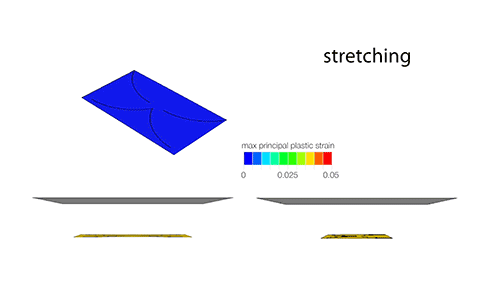The Japanese Art if Foli G Psper Is Kniwn as What?
/https://tf-cmsv2-smithsonianmag-media.s3.amazonaws.com/filer/a0/11/a01129ea-2c4a-41d1-b97b-e7bc9e615956/mit-shoe-grip-01-press.jpg)
Engineers working on technological innovations from solar cells to stretchy electronics have drawn inspiration from the Japanese fine art of kirigami. The lesser-known cousin of origami, which involves cutting and folding newspaper, helps to create three-dimensional shapes from flat, paper-similar materials or to add form-fitting flexibility.
Now scientists using kirigami have developed a new type of no-skid shoe sole that mimics the texture of snakeskin, reports Nicola Davis for the Guardian. The authors of the new research, published this week in the journal Nature Biomedical Engineering , say their innovation could assistance cut down on injuries from falls, particularly amid older people.
"Falls are the leading cause of death for older adults and the second leading cause of occupational-related deaths," Giovanni Traverso, an engineer at the Massachusetts Institute of Technology and co-writer of the new research, says in a statement from Harvard University. "If we could control and increase the friction between the states and the basis, we could reduce the hazard of these types of falls, which not just cost lives but billions of dollars in medical bills every twelvemonth."
The paper besides cites prior research showing that broken hips are among the injuries that can result from slip-and-autumn incidents and that nearly half of older patients with hip fractures are unable to return to living independently.
"Through this work nosotros set out to address the claiming of preventing falls, particularly on icy, glace surfaces, and developed a kirigami-based organization that facilitates an increment of friction with a surface," says Traverso in a statement from MIT.

The grippy new sole is made of a sparse sheet of steel that is riddled with precise cuts that allow information technology to bristle similar the scales of a snake when bent, co-ordinate to a statement from Harvard University nigh the new research. The kirigami-way cuts in the steel sheet allow it to transform from a polish surface into a spiked sole set to dig in for traction, and dorsum once again.
"What we are trying to do is augment, or add on, to [existing systems like studs or rubber soles] to have a improve grip on glace surfaces, whether it be ice or whether it be oily surfaces in certain occupations," Traverso tells the Guardian. He also says the kirigami soles were inspired by "friction-enhancing" adaptations in nature, such as snakeskin, which allows serpents to slither through their environment, and the semi-retractable claws of cheetahs, which can be extended to provide extra traction during loftier-speed pursuit of prey.
To develop the blueprint of cuts used in their prototype soles, the researchers conducted a series of experiments testing the friction generated past dissimilar patterns, materials, shapes and arrangements on diverse surfaces, according to the argument from MIT. They eventually found that cuts of interlocking concave curves worked all-time and tested them on the shoes of man volunteers walking across a one-inch thick sheet of ice. The special soles created roughly 20 to 35 percentage more friction than standard shoes and boots on their own, reports Andrew Liszewski of Gizmodo . The new traction system outperformed traditional crampons on ice in the researchers' tests and were both lighter and easier to take on and off, according to the Harvard statement.

"By adding [dimpling to the sole] and combining with kirigami needles, nosotros expect to find further friction enhancement, [above] 35 percent," Sahab Babaee, an engineer at MIT and beginning author of the enquiry, tells the Guardian.
"Walking is a dynamic process so we wanted to develop a system that was besides dynamic and could answer to movement," Traverso adds.
Though the researchers initially set out to prevent water ice-related slips, they call back their grippy soles could also have broader commercial applications in moisture or oil-slicked work places, co-ordinate to the argument from MIT.
"Nosotros see this either as an improver or it could be incorporated into the sole directly," Traverso tells the Guardian. "We hope that [people] tin can rush out and purchase these shortly, and that is what nosotros are working towards."
Source: https://www.smithsonianmag.com/smart-news/new-no-slip-sole-takes-inspiration-from-japanese-art-kirigami-180975025/
0 Response to "The Japanese Art if Foli G Psper Is Kniwn as What?"
Post a Comment